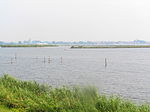Veluwemeer Aqueduct
2002 establishments in the Netherlands21st-century architecture in the NetherlandsDutch building and structure stubsHarderwijkNavigable aqueducts

Veluwemeer Aqueduct is a 25-metre (82 ft) long, 19 meter wide, navigable aqueduct (also known as a water bridge) located over Veluwemeer lake in Harderwijk, Netherlands. It was opened in 2002 and bypasses the N302 road. Where the aqueduct crosses the N302, the depth of water is three metres (9.83 feet), which allows vessels to pass over the road safely, so long as their draft is less. There are also pedestrian crossings on both sides of the waterway.The construction of the aqueduct took some 22,000 cubic metres of concrete, plus steel sheet piling to bear the heavy weight of the water over the road and to prevent water and sediment from leaking onto the road below.
Excerpt from the Wikipedia article Veluwemeer Aqueduct (License: CC BY-SA 3.0, Authors, Images).Veluwemeer Aqueduct
Knardijk,
Geographical coordinates (GPS) Address External links Nearby Places Show on map
Geographical coordinates (GPS)
| Latitude | Longitude |
|---|---|
| N 52.360952777778 ° | E 5.6184888888889 ° |
Address
Knardijk
Knardijk
3846 AH (Harderwijk)
Gelderland, Netherlands
Open on Google Maps






